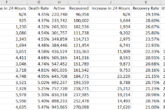
The Lead
With golf courses reopening since May, many are generating impressive cash flow. Perhaps the pandemic has created a unique opportunity to ask, “How is golf going to evolve over the need decade and what are the implications for a golf course owner’s long-term survival?”
The Article
With the help of some industry leaders — Eddie Ainsworth, PGA Executive Director, Colorado PGA; Mike Cutler, Billy Casper Golf Management; Jim Hajek, PGA, Director of Golf at Fossil Trace; Mark Pfingston, PGA, Director of Golf at Golf Club at Bear Dance; and Del Ratcliffe, PGA of Ratcliffe Golf Services — we collectively speculated as to how the golf experience might evolve along the 16 customer touchpoints on the “assembly line of golf.”
Shown here are the initial touchpoints from the desire to play until loading the golf bag on the cart:
As the golfer begins the round heading to the range via a cart, Golfboard, or merely carrying their clubs, the future opportunities to enhance the experience are shown here:
The changes these golf industry leaders anticipate will be drive by the evolution of technology. Will these changes come to pass?
Facial recognition and artificial intelligence are evolving quickly, creating many ethical debates. Brad Smith, President of Microsoft, and Carol Ann Browne, Senior Director, External Relations & Executive Communications, refer to the challenges in their compelling book, “Tools and Weapons.” Shoshana Zuboff, Ph.D. and professor at Harvard in “The Age of Surveillance Capitalism – The Fight for A Human Future at the New Frontier of Power,” chronicles the massive amount of consumer data that is being aggregated and sold. The trade-off is clear: convenience vs. privacy. While some would debate you can have both, it is unlikely.
Golf courses are latent adopters of cultural trends and technologies. The evolution of social media and increased concerns about creative economic destruction is an essential tenet of capitalism. The biggest challenge facing the golf course is the cost of labor.
With the evolution of GPS, we can expect that autonomous mowers will be developed, albeit with some fits and starts. Jim Hajek, PGA, Head Golf Professional at the impressive Fossil Trace in Golden, Colorado, stated, “If I could reduce the size of my maintenance staff by 25% with the use of GPS equipment that allowed for the raking of bunkers and fixing ball marks on all 18 holes before a 7:00 a.m. shotgun, count me in.” Though the investment for five mowers would be nearly $350,000, the return on investment could be under five years.
Another significant investment in the future could be, “What is the ideal clubhouse?” I sense that they will vary greatly depending on the vision of the facility and the fees charged. For the golf course whose green fees are under $60, the concept of one large “community center,” which handles functions currently performed by the Pro Shop and the Restaurant, is anticipated. The Blue Sky Golf Club in Jacksonville, FL, implemented that concept with great success.
Mark Pfingston, Director of Golf at the Golf Club at Bead Dance, believes that the golf course clubhouses will evolve from a singular purpose to a multi-faceted facility, combining indoor and outdoor elements, with each one having their own private and unique environments. Mark thinks that golf courses in the northern part of the U.S., with a season of fewer than 300 days, must diversify their activities to facilitate being open year-round.
He sees the competition as bowling alleys, movie theaters, sports parks, and the plethora of youth sports that divert the attention of parents. He ponders why golf hasn’t embraced the concept of year-round golf for juniors, leveraging the indoor aspects. His creative mind envisions the screen image, not of a golf course, but of a Spiderman or Superman movie. The junior aims to hit the villains on the screen with his shots for points, similar to an arcade.
While golf simulators are expensive, they provide fabulous benefits, such as being able to retain staff year-round, providing indoor training for juniors and new golfers throughout the year, and facilitating custom club fitting. And there is a great advantage to learning indoors. The bad shots, Mark states, are not magnified indoors, like they are outdoors, and learning on mats as a beginner is far more comfortable than on grass.
Other options are modular components, like those offered at wework.com, which members can rent hourly, and business meeting space that features golf simulators and screens for PowerPoint presentations. Also, weddings, baby showers, and other activities historically handled by private catering firms will be an integrated service of the evolving golf facility.
For the high-end daily fee golf course, a multi-level “wheel and spoke concept” might evolve to eliminate noise pollution of the golfer at the bar in shorts interacting with the individual attending a wedding in a tuxedo or impressive gown. Administrative offices for the staff would likely be sequestered away from the traffic flow. The clubhouse might evolve as a business center, an outing facility, and oh yes, a venue for golfers.
The concepts presented above have a central tenet: providing the customer with a consistent experience where they are empowered to serve themselves and leveraging technology to create personalization in their experience.
Here are 20 additional ways our society is likely to change (click here). Technology is going to greatly evolve of its own momentum and also spurred by COVID-19. The question that remains is, “Will you, as a golf course owner, adapt quickly enough to remain competitive in the golf industry?”
Author: James J. Keegan, Envisioning Strategist, and Reality Mentor. Keegan was named one of the Top 10 Golf Consultants and Golf Advisor of the Year in 2017 by Golf, Inc. Keegan has traveled more than 2,984,000 miles on United Airlines, visiting over 250 courses annually and meeting with owners and key management personnel at more than 6,000 courses in 58 countries. His sixth book, “The Winning Playbook for Golf Courses: Shorts-Cuts for Long-Term Financial Success,” was released on June 20, 2020. Click here.



